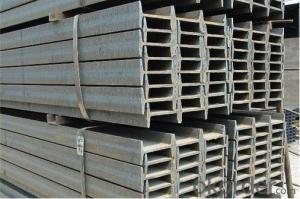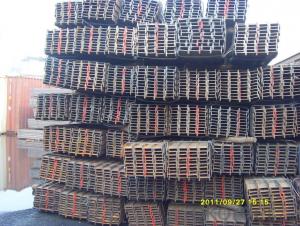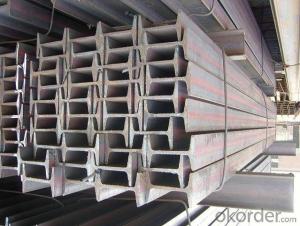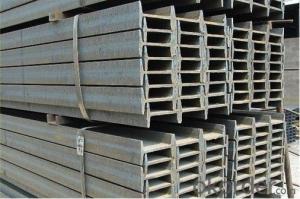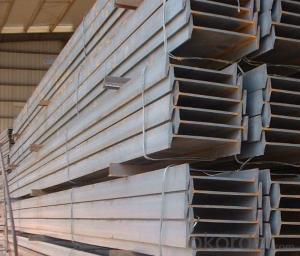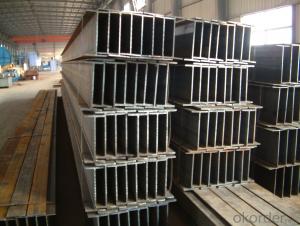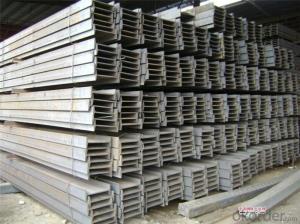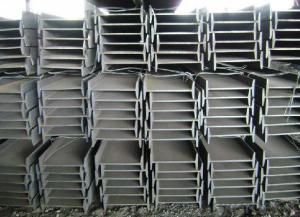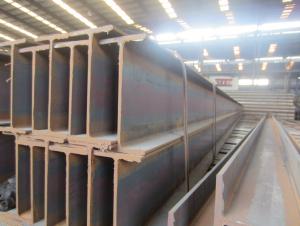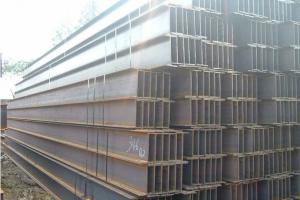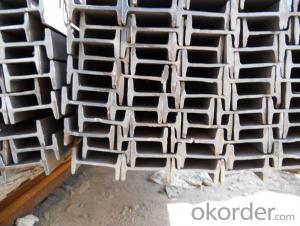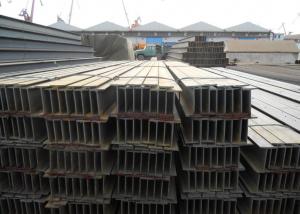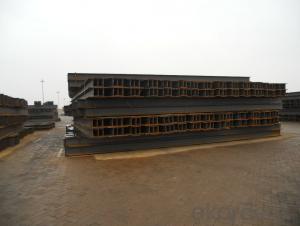Hot Rolled IPE and IPEAA Beams Grade Q235 Steel H-Beams
- Loading Port:
- China main port
- Payment Terms:
- TT OR LC
- Min Order Qty:
- 50 m.t.
- Supply Capability:
- 10000 m.t./month
OKorder Service Pledge
OKorder Financial Service
You Might Also Like
Hot Rolled IPE and IPEAA Beams Grade Q235 Steel I-Beams
Product Description:
OKorder is offering high quality Hot Rolled Steel I-Beams at great prices with worldwide shipping. Our supplier is a world-class manufacturer of steel, with our products utilized the world over. OKorder annually supplies products to European, North American and Asian markets. We provide quotations within 24 hours of receiving an inquiry and guarantee competitive prices.
Applications:
Hot Rolled Steel I-Beams are ideal for structural applications and are widely used in the construction of buildings and bridges, and the manufacturing, petrochemical, and transportation industries.
Advantages:
OKorder's Steel I-Beams are durable, strong, and resist corrosion.
Main Features:
· Premium quality
· Prompt delivery & seaworthy packing (30 days after receiving deposit)
· Corrosion resistance
· Can be recycled and reused
· Mill test certification
· Professional Service
· Competitive pricing
Specifications:
Manufacture: Hot rolled
Grade: Q195 – 235
Certificates: ISO, SGS, BV, CIQ
Length: 6m – 12m, as per customer request
Chinese Standard (H*W*T) | Weight (Kg/m) | 6m (pcs/ton) | Light I (H*W*T) | Weight (Kg/m) | 6m (pcs/ton) | Light II (H*W*T) | Weight (Kg/m) | 6M |
100*68*4.5 | 11.261 | 14.8 | 100*66*4.3 | 10.13 | 16.4 | 100*64*4 | 8.45 | 19.7 |
120*74*5.0 | 13.987 | 11.9 | 120*72*4.8 | 12.59 | 13.2 | 120*70*4.5 | 10.49 | 15.8 |
140*80*5.5 | 16.89 | 9.8 | 140*78*5.3 | 15.2 | 10.9 | 140*76*5 | 12.67 | 13.1 |
160*88*6 | 20.513 | 8.1 | 160*86*5.8 | 18.46 | 9 | 160*84*5.5 | 15.38 | 10.8 |
180*94*6.5 | 24.143 | 6.9 | 180*92*6.3 | 21.73 | 7.6 | 180*90*6 | 18.11 | 9.2 |
200*100*7 | 27.929 | 5.9 | 200*98*6.8 | 25.14 | 6.6 | 200*96*6.5 | 20.95 | 7.9 |
220*110*7.5 | 33.07 | 5 | 220*108*7.3 | 29.76 | 5.6 | 220*106*7 | 24.8 | 6.7 |
250*116*8 | 38.105 | 4.3 | 250*114*7.8 | 34.29 | 4.8 | 250*112*7.5 | 28.58 | 5.8 |
280*122*8.5 | 43.492 | 3.8 | 280*120*8.2 | 39.14 | 4.2 | 280*120*8 | 36.97 | 4.5 |
300*126*9 | 48.084 | 3.4 | 300*124*9.2 | 43.28 | 3.8 | 300*124*8.5 | 40.87 | 4 |
320*130*9.5 | 52.717 | 3.1 | 320*127*9.2 | 48.5 | 3.4 | |||
360*136*10 | 60.037 | 2.7 | 360*132*9.5 | 55.23 | 3 |
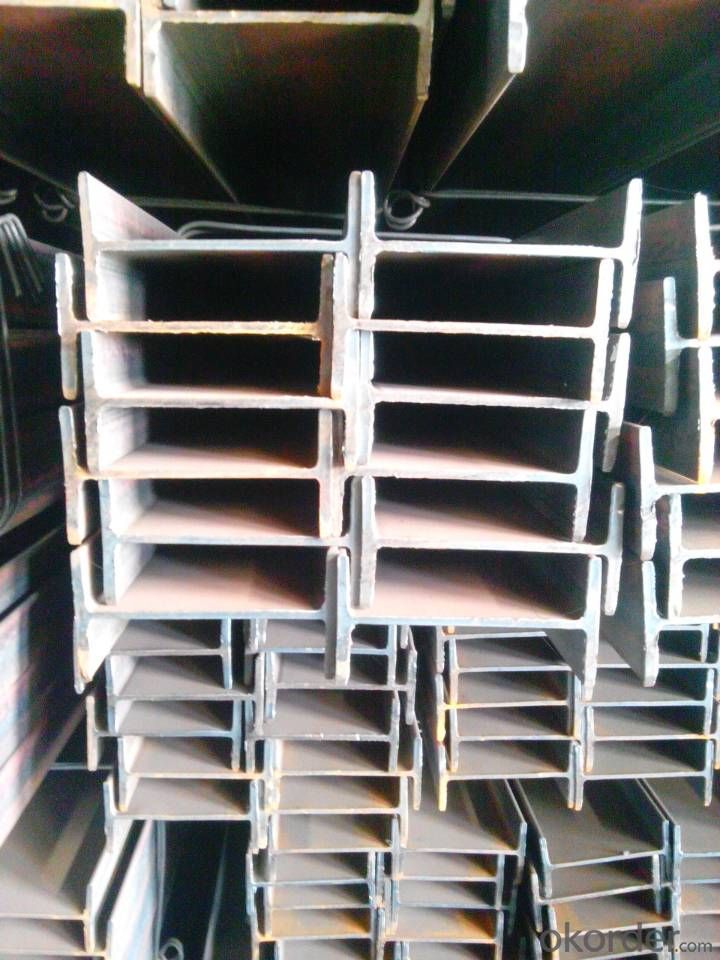
- Q: How do steel H-beams perform in areas with high levels of seismic activity?
- Steel H-beams are widely considered as an optimal option for construction in regions prone to seismic activity due to their exceptional structural integrity and resilience against earthquakes. The distinctive design of H-beams, characterized by wide flanges and a thicker web, ensures their effectiveness. Fabricated from steel, renowned for its high strength and ductility, H-beams possess the ability to absorb and dissipate energy generated during seismic events, thereby minimizing damage and safeguarding the overall structural integrity of buildings. The combination of the H-shape and steel material enables these beams to withstand lateral forces, vibrations, and ground motion more efficiently than alternative structural members. Additionally, steel H-beams offer the advantage of being lightweight when compared to materials such as concrete or timber. This reduction in overall mass decreases the seismic forces acting upon the structure, further enhancing their resistance. The decreased mass also diminishes inertia forces during earthquakes, enhancing the building's ability to withstand shaking and reducing the risk of structural failure. Flexibility is another benefit of steel H-beams as they can be easily fabricated and installed, allowing for efficient construction in areas with seismic activity. Furthermore, these beams can be readily reinforced or retrofitted to enhance their seismic performance, ensuring that buildings constructed with steel H-beams meet specific seismic design criteria and regulations, providing an additional layer of safety. In conclusion, steel H-beams are an excellent choice for regions with high levels of seismic activity. Their robust and ductile properties, coupled with their lightweight and flexible nature, enable them to withstand lateral forces and vibrations generated during earthquakes. Properly designed and installed, steel H-beams significantly contribute to the overall seismic resilience and safety of structures in these areas.
- Q: How do steel H-beams contribute to the ease of future expansions or modifications?
- Steel H-beams contribute to the ease of future expansions or modifications due to their structural properties and versatility. Firstly, steel H-beams are known for their high strength-to-weight ratio, which makes them capable of carrying heavy loads while being relatively lightweight. This means that they can be used to support the additional weight of future expansions or modifications without adding significant extra weight to the existing structure. This is particularly important in situations where the overall load capacity of the building or structure needs to be increased. Secondly, steel H-beams provide flexibility in terms of design and construction. These beams can be easily cut, welded, or bolted together, allowing for modifications or extensions to be seamlessly integrated into the existing structure. The ability to easily connect and disconnect steel H-beams makes it possible to add or remove sections as needed, without compromising the overall structural integrity. Furthermore, steel H-beams offer long-term durability and resistance to corrosion, which is crucial for future expansions or modifications. The use of steel ensures that the structure will remain stable and strong even after years of exposure to environmental factors, such as moisture or extreme temperatures. This durability minimizes the need for frequent repairs or replacements, reducing the overall cost and effort required for future modifications. Additionally, steel H-beams are available in a wide range of sizes and shapes, allowing for customizations according to the specific needs of a project. This versatility enables architects and engineers to design and create complex structures with ease, accommodating different expansion requirements or modifications as they arise. In conclusion, steel H-beams contribute to the ease of future expansions or modifications by providing a strong, lightweight, and flexible structural solution. Their ability to support heavy loads, accommodate design changes, and withstand environmental factors makes them a valuable choice for construction projects that require adaptability and longevity.
- Q: Are steel H-beams resistant to chemical exposure?
- The resistance of steel H-beams to chemical exposure is generally high. Steel is renowned for its durability and strength, which grants it resistance against numerous chemical substances. However, the level of resistance may vary depending on the specific chemicals and duration of exposure. Typically, steel H-beams can endure exposure to common chemicals found in industrial and construction environments, including oils, solvents, acids, and alkalis. Moreover, they exhibit resistance to atmospheric corrosion, making them advantageous for outdoor applications. Nonetheless, it is crucial to acknowledge that extended exposure to highly corrosive chemicals or extreme conditions can still cause detrimental effects on steel. Substances like strong acids or bases, aggressive salts, or highly oxidizing agents can induce corrosion or degradation over time. To ensure optimal resistance to chemical exposure, seeking advice from professionals or experts in the field is advisable. They can offer guidance regarding the specific chemicals involved and suggest suitable protective coatings or treatments for the steel beams.
- Q: Can steel H-beams be used for multi-story buildings?
- Indeed, multi-story buildings can utilize steel H-beams. These beams, also referred to as I-beams, are frequently employed in the field of construction owing to their robustness and capacity to bear loads. The purpose of these beams is to evenly distribute the weight of the building and offer structural reinforcement. Their unique shape enhances stability and resistance against bending or twisting forces. Steel H-beams are commonly employed in the construction of multi-story buildings due to their aptitude for supporting hefty loads and providing a sturdy framework. Additionally, steel is a resilient material that can withstand diverse weather conditions, rendering it a favored choice for high-rise construction.
- Q: Are steel H-beams suitable for use in earthquake-prone areas?
- Yes, steel H-beams are suitable for use in earthquake-prone areas. Steel has excellent strength and ductility, making it highly resistant to seismic forces. H-beams, with their structural stability and ability to distribute loads, are commonly used in earthquake-resistant construction.
- Q: How do steel H-beams perform in heavy snow loads?
- Steel H-beams perform exceptionally well in heavy snow loads due to their structural strength and durability. The H-shape design of the beam provides excellent load-bearing capabilities, allowing it to withstand the weight of accumulated snow without deformation or failure. Additionally, steel is known for its resistance to extreme weather conditions, including snow and ice, making H-beams a reliable choice for structures in snowy areas.
- Q: Can steel H-beams be used in the construction of museums or cultural buildings?
- Yes, steel H-beams can definitely be used in the construction of museums or cultural buildings. Steel H-beams are commonly used in the construction industry due to their strength, durability, and versatility. They are designed to provide structural support, making them ideal for large-scale buildings like museums or cultural centers. The use of steel H-beams in construction offers several advantages. Firstly, their high strength-to-weight ratio allows for the creation of large open spaces without the need for excessive columns or supports, thus providing more flexibility in architectural design. This is especially important for museums or cultural buildings where open and spacious areas are often desired to display exhibits or host events. Furthermore, steel H-beams are capable of withstanding heavy loads and providing structural stability, making them suitable for supporting the weight of artistic installations, sculptures, or other heavy artifacts that might be found in museums or cultural buildings. In addition, steel H-beams can be easily fabricated to meet specific design requirements, allowing architects and engineers to create unique and aesthetically pleasing structures. This is especially important in cultural buildings where the architectural design often plays a significant role in the overall impact and experience for visitors. Lastly, steel H-beams have excellent fire-resistant properties, which is crucial for buildings that store and display valuable and irreplaceable artifacts. Steel is non-combustible and does not contribute to the spread of fire, ensuring the safety of both the building and its contents. Overall, steel H-beams are a reliable and cost-effective choice for the construction of museums or cultural buildings. They offer structural integrity, design versatility, and fire resistance, making them an excellent option for creating functional and visually appealing spaces to showcase art, history, or cultural heritage.
- Q: What are the different design considerations when using steel H-beams in architectural projects?
- When incorporating steel H-beams into architectural projects, it is vital to take several design factors into account. These factors encompass the following: 1. Ensuring Structural Stability: The primary purpose of using steel H-beams is their ability to bear heavy loads. Therefore, it is crucial to analyze the load distribution, deflection, and stress on the beams to guarantee their structural stability and their ability to safely support the intended loads. 2. Determining Span and Size: The load-bearing capacity of steel H-beams greatly depends on their span and size. To maintain structural integrity and prevent potential issues like excessive deflection or bending, architects must carefully select the appropriate beam size and span based on the requirements of the architectural project. 3. Establishing Connection Details: The connection details between steel H-beams and other structural elements are of utmost importance in creating a strong and dependable architectural design. By designing proper connections, architects can efficiently transfer loads, minimize stress concentrations, and facilitate construction and maintenance. 4. Addressing Fire Resistance: While steel H-beams possess inherent fire-resistant properties, certain architectural projects may necessitate additional fire protection measures to adhere to local building codes and safety regulations. These measures may involve the use of fire-resistant coatings or fireproofing materials to enhance the overall fire resistance of the structure. 5. Incorporating Aesthetics and Design Integration: Although primarily structural, steel H-beams can contribute to the overall visual appeal of an architectural project. By integrating the beams into the design in an aesthetically pleasing manner, architects can enhance the project's attractiveness. This could involve exposing the beams or incorporating them into architectural features to achieve an industrial or modern aesthetic. 6. Emphasizing Sustainability: In contemporary architectural projects, prioritizing sustainability is crucial. Steel is a highly sustainable material due to its recyclability and reusability. Therefore, architects must maximize the use of sustainable materials and minimize waste when incorporating steel H-beams into their designs. 7. Considering Cost Efficiency: Lastly, the cost efficiency of utilizing steel H-beams should be taken into consideration. Architects must evaluate the cost of materials, fabrication, transportation, and installation in relation to the project's budget and design requirements. By effectively planning and coordinating with structural engineers and contractors, cost efficiency can be optimized without compromising safety or quality. To summarize, design considerations for incorporating steel H-beams into architectural projects encompass structural stability, span and size determination, connection details, fire resistance, aesthetics and design integration, sustainability, and cost efficiency. By addressing these considerations, architects can ensure the successful integration of steel H-beams into their designs, resulting in safe, visually appealing, and sustainable structures.
- Q: Can steel H-beams be used for gymnasiums?
- Yes, steel H-beams can be used for gymnasiums. Steel H-beams are commonly used in construction due to their strength and structural integrity. They provide excellent support for large spans and heavy loads, making them suitable for gymnasiums which often require open spaces and high ceilings. Additionally, steel H-beams can be easily customized and fabricated to meet specific design requirements, allowing for flexibility in gymnasium design. Their durability and resistance to fire, pests, and structural decay also make them a reliable choice for gymnasium construction. Overall, steel H-beams are a popular and effective option for building gymnasiums.
- Q: Can steel H-beams be used in the construction of shopping centers or malls?
- Yes, steel H-beams can be used in the construction of shopping centers or malls. Steel H-beams are commonly used in commercial construction due to their strength, durability, and versatility. They provide excellent support for the structural framework of buildings, allowing for large open spaces and flexible floor plans that are often required in shopping centers and malls. Additionally, steel H-beams can withstand heavy loads and are resistant to fire and other potential hazards. Their use in construction projects ensures the safety and long-lasting stability of shopping centers and malls.
Send your message to us
Hot Rolled IPE and IPEAA Beams Grade Q235 Steel H-Beams
- Loading Port:
- China main port
- Payment Terms:
- TT OR LC
- Min Order Qty:
- 50 m.t.
- Supply Capability:
- 10000 m.t./month
OKorder Service Pledge
OKorder Financial Service
Similar products
Hot products
Hot Searches
Related keywords
